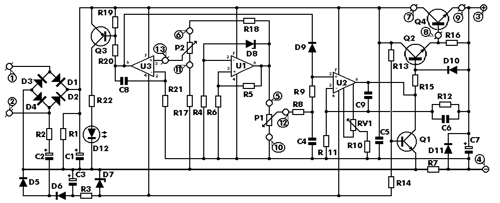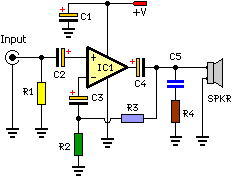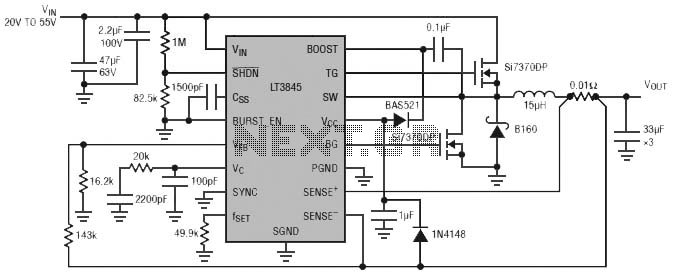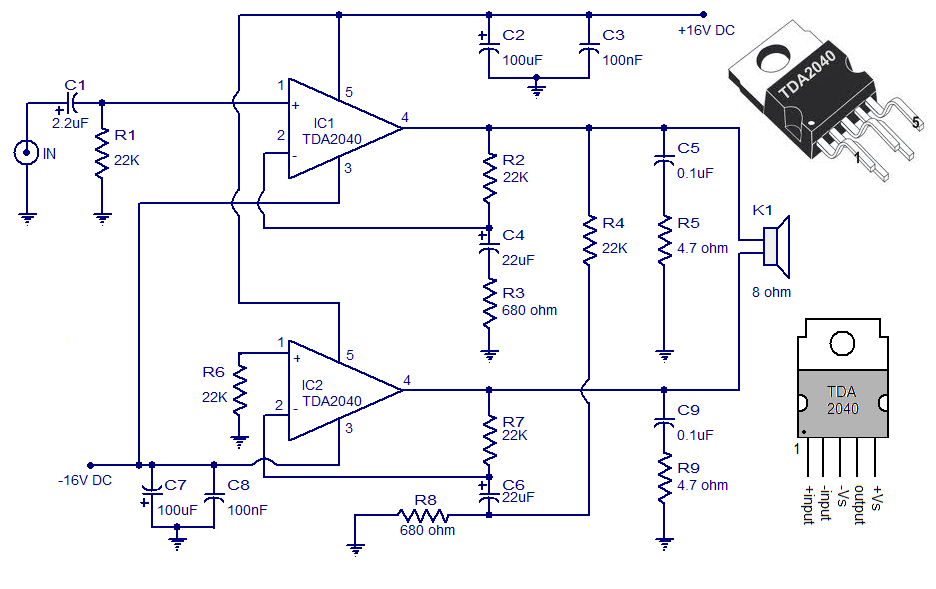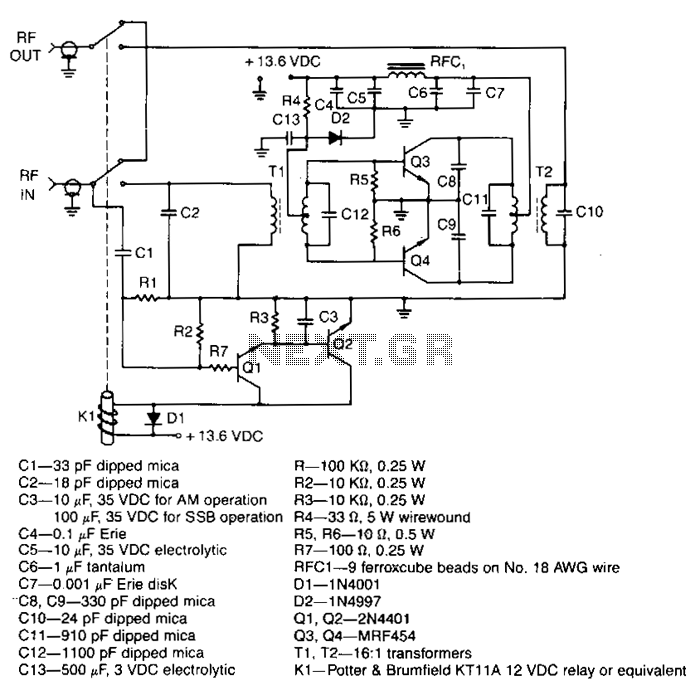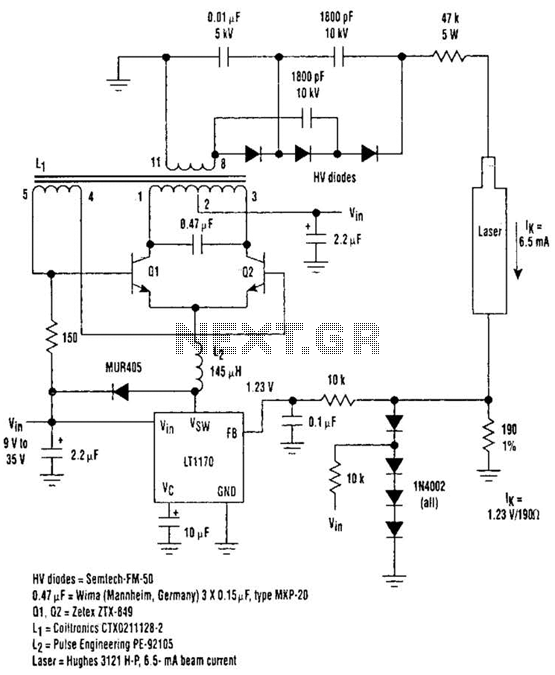
5000W ultra-light high-power amplifier without switching-mode power supply
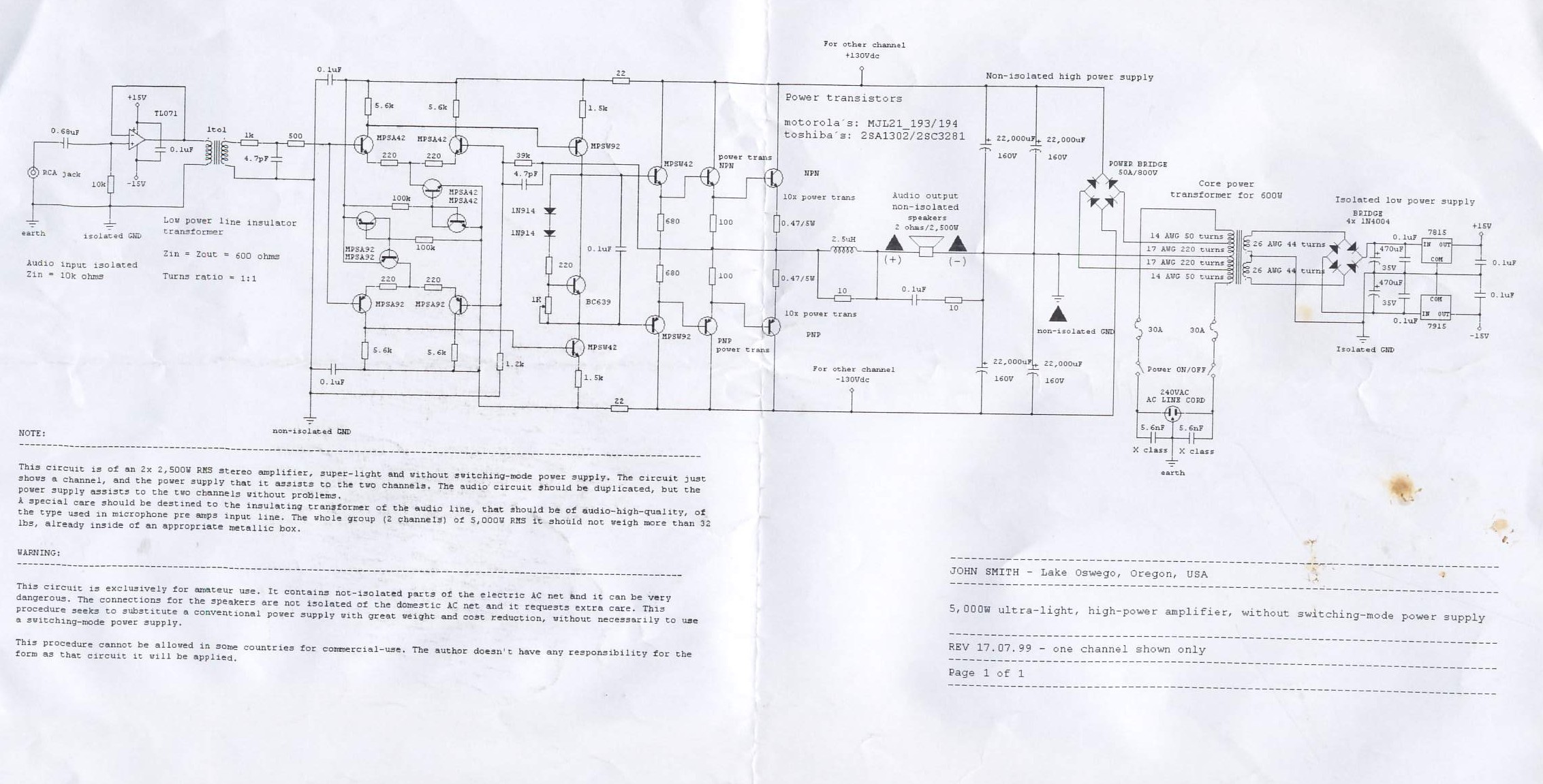
This circuit is for a 2x2, 500W RMS stereo amplifier that is super-light and does not utilize a switching-mode power supply. The circuit diagram displays only one channel, while the power supply is designed to support both channels. The audio circuit must be duplicated for full functionality, but the power supply can adequately serve both channels without issue. Special attention should be given to the insulating transformer of the audio line, which should be of high audio quality, similar to those used in microphone preamp input lines. The combined output of both channels is 5,000W RMS and should not exceed 32 lbs when housed in a suitable metallic enclosure. This circuit is intended solely for amateur use. It contains non-isolated components connected to the AC mains, which can pose significant hazards. The speaker connections are not isolated from the domestic AC network, requiring additional caution. This design aims to replace a conventional power supply, achieving significant weight and cost savings without resorting to a switching-mode power supply. However, this approach may not be permissible for commercial use in certain countries. The author disclaims any responsibility for how this circuit may be applied.
This circuit design features a dual-channel amplifier capable of delivering 2x 500W RMS output. The architecture is lightweight, making it suitable for portable applications, and it intentionally avoids the complexities and weight associated with traditional switching-mode power supplies. The schematic primarily illustrates one channel, with the understanding that a second identical circuit is to be replicated for stereo functionality. The power supply is engineered to efficiently support both channels, ensuring reliable performance.
Critical to the circuit's operation is the selection of a high-quality insulating transformer. This component is essential for maintaining audio fidelity and minimizing noise, particularly in sensitive audio applications like microphone preamps. The transformer should be rated for audio applications to ensure optimal performance.
The combined power output of the amplifier is rated at 5,000W RMS, making it suitable for various amateur audio setups, such as home theaters or live sound reinforcement. The design emphasizes portability, with the entire assembly, including the power supply and amplifier circuits, weighing no more than 32 lbs when enclosed in a robust metallic chassis. This weight consideration is crucial for users who may need to transport the amplifier frequently.
Safety is a paramount concern in this design. The circuit contains components that are not isolated from the AC mains, which introduces risks of electric shock. Users must exercise caution when handling the device, particularly when connecting speakers, as these connections are also not isolated from the domestic AC network. It is imperative to implement safety measures to mitigate these risks, especially in amateur applications where users may lack extensive electrical knowledge.
This circuit represents an innovative approach to audio amplification, prioritizing weight and cost efficiency while maintaining performance. However, it is essential to note that the design may not comply with commercial regulations in certain jurisdictions, and users must assume responsibility for the application of this circuit.This circuit is of an 2x 2, 500W RMS stereo amplifier, super-light and without switching-mode power supply. The circuit just shows a channel, and the power supply that it assists to the two channels. The audio circuit should be duplicated, but the power supply assists to the two channels without problems.
A special care should be destined to the in sulating transformer of the audio line, that should be of audio-high-quality, of the type used in microphone pre amps input line. The whole group (2 channels) of 5, 000W RMS it should not weigh more than 32 lbs, already inside of an appropriate metallic box.
This circuit is exclusively for amateur use. It contains not-isolated parts of the electric AC net and it can be very dangerous. The connections for the speakers are not isolated of the domestic AC net and it requests extra care. This procedure seeks to substitute a conventional power supply with great weight and cost reduction, without necessarily to use a switching-mode power supply. This procedure cannot be allowed in some countries for commercial-use. The author doesn`t have any responsibility for the form as that circuit it will be applied. 🔗 External reference
This circuit design features a dual-channel amplifier capable of delivering 2x 500W RMS output. The architecture is lightweight, making it suitable for portable applications, and it intentionally avoids the complexities and weight associated with traditional switching-mode power supplies. The schematic primarily illustrates one channel, with the understanding that a second identical circuit is to be replicated for stereo functionality. The power supply is engineered to efficiently support both channels, ensuring reliable performance.
Critical to the circuit's operation is the selection of a high-quality insulating transformer. This component is essential for maintaining audio fidelity and minimizing noise, particularly in sensitive audio applications like microphone preamps. The transformer should be rated for audio applications to ensure optimal performance.
The combined power output of the amplifier is rated at 5,000W RMS, making it suitable for various amateur audio setups, such as home theaters or live sound reinforcement. The design emphasizes portability, with the entire assembly, including the power supply and amplifier circuits, weighing no more than 32 lbs when enclosed in a robust metallic chassis. This weight consideration is crucial for users who may need to transport the amplifier frequently.
Safety is a paramount concern in this design. The circuit contains components that are not isolated from the AC mains, which introduces risks of electric shock. Users must exercise caution when handling the device, particularly when connecting speakers, as these connections are also not isolated from the domestic AC network. It is imperative to implement safety measures to mitigate these risks, especially in amateur applications where users may lack extensive electrical knowledge.
This circuit represents an innovative approach to audio amplification, prioritizing weight and cost efficiency while maintaining performance. However, it is essential to note that the design may not comply with commercial regulations in certain jurisdictions, and users must assume responsibility for the application of this circuit.This circuit is of an 2x 2, 500W RMS stereo amplifier, super-light and without switching-mode power supply. The circuit just shows a channel, and the power supply that it assists to the two channels. The audio circuit should be duplicated, but the power supply assists to the two channels without problems.
A special care should be destined to the in sulating transformer of the audio line, that should be of audio-high-quality, of the type used in microphone pre amps input line. The whole group (2 channels) of 5, 000W RMS it should not weigh more than 32 lbs, already inside of an appropriate metallic box.
This circuit is exclusively for amateur use. It contains not-isolated parts of the electric AC net and it can be very dangerous. The connections for the speakers are not isolated of the domestic AC net and it requests extra care. This procedure seeks to substitute a conventional power supply with great weight and cost reduction, without necessarily to use a switching-mode power supply. This procedure cannot be allowed in some countries for commercial-use. The author doesn`t have any responsibility for the form as that circuit it will be applied. 🔗 External reference
Warning: include(partials/cookie-banner.php): Failed to open stream: Permission denied in /var/www/html/nextgr/view-circuit.php on line 713
Warning: include(): Failed opening 'partials/cookie-banner.php' for inclusion (include_path='.:/usr/share/php') in /var/www/html/nextgr/view-circuit.php on line 713
